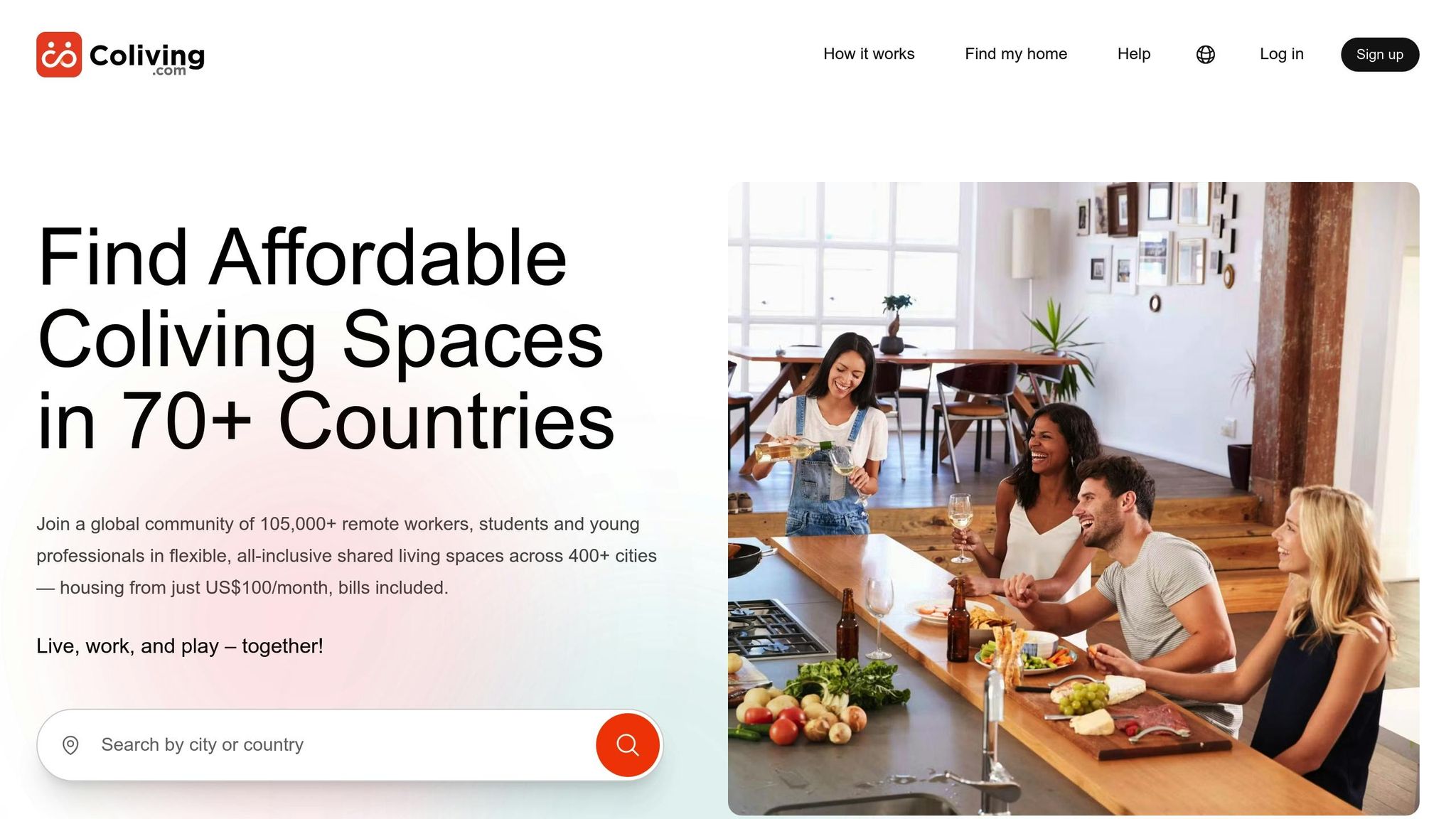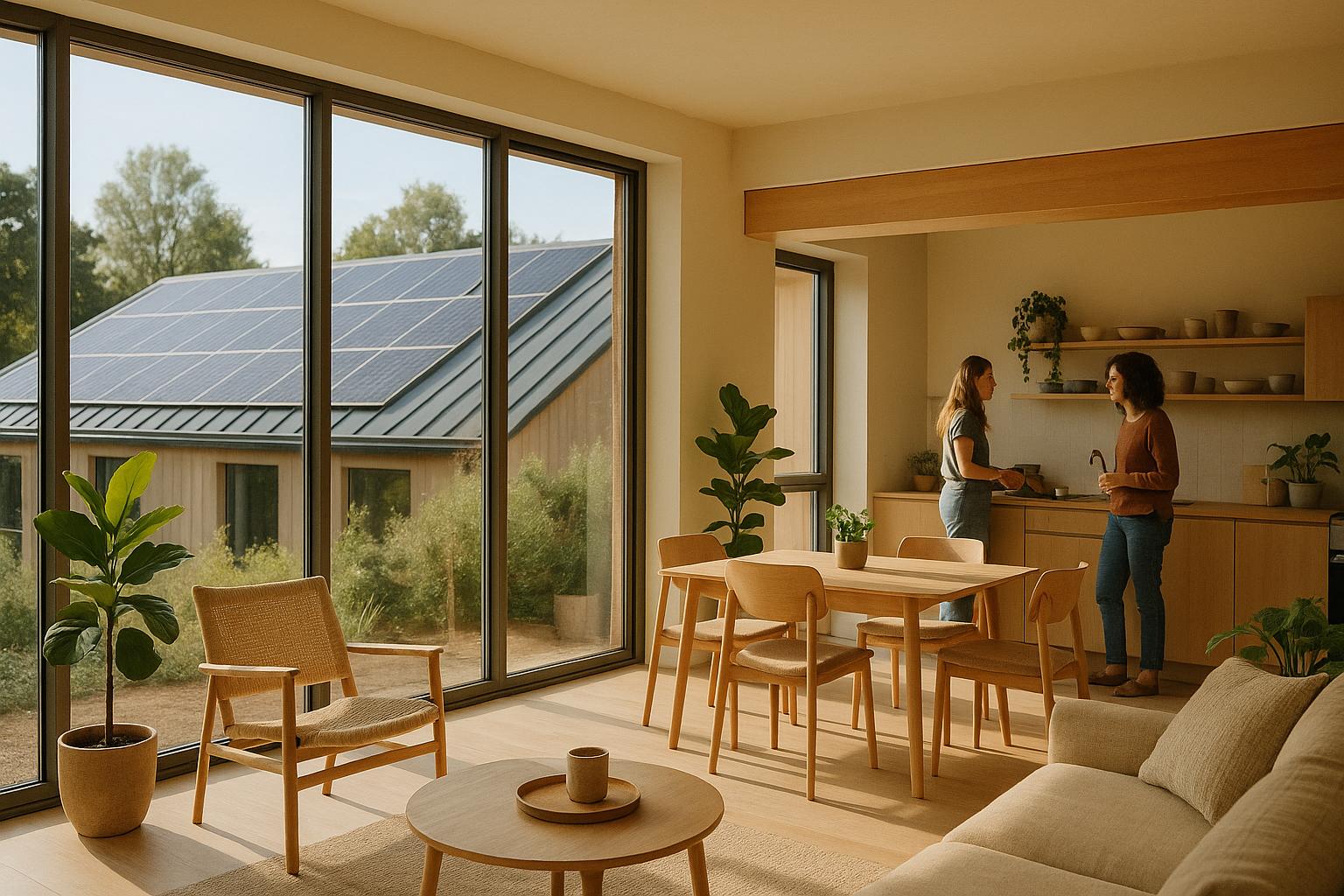Finding the right pricing strategy is critical for coliving operators. Why? It’s the key to balancing profitability, affordability, and creating a community-focused living experience. Coliving spaces need to account for bundled services like utilities, internet, and cleaning, while offering flexible lease terms and competitive rates. Here’s a breakdown of effective pricing models:
- Tiered Pricing: Offers different price levels based on room types, amenities, or lease lengths. For example, private rooms cost more than shared spaces, and month-to-month leases are priced higher than long-term agreements.
- Subscription-Based Pricing: Residents pay a flat, all-inclusive monthly fee covering rent, utilities, and services. Optional add-ons (e.g., premium cleaning) can boost income.
- Dynamic Pricing: Adjusts rates in real-time based on demand, seasonality, and occupancy levels. This model maximizes revenue but requires constant monitoring.
Each model has its strengths and trade-offs, and many hosts combine elements from multiple strategies to suit their property and market. Tools like Coliving.com simplify pricing management, offering insights into trends and enabling flexible rate structures. Ultimately, success lies in understanding resident needs, local market conditions, and maintaining transparent pricing.
Pricing Models for Coliving Hosts
Choosing the right pricing model can make or break the success of a coliving space. By aligning your pricing strategy with property features, resident expectations, and market trends, you can boost profitability while keeping your space appealing. Here’s a breakdown of three effective pricing models to consider.
Tiered Pricing
This model introduces different price levels within the same property, catering to a wider range of residents by offering varied options in comfort and services.
- Room-based tiers: Perfect for larger properties, this approach lets you offer shared accommodations, private rooms, or premium suites with added perks. Pricing should reflect factors like room size, location within the property, and local market rates.
- Amenity-based tiers: Residents can pick the level of service that fits their lifestyle. A basic plan might cover essentials like housing, while higher tiers could include extras like housekeeping, laundry, or access to exclusive events.
- Lease length tiers: Offering different rates based on lease duration provides flexibility. For instance, month-to-month leases might come at a higher rate, while longer-term agreements could offer discounts to encourage extended stays.
Subscription-Based Pricing
Think of this approach as an all-inclusive package. Residents pay a flat monthly fee that covers housing, utilities, internet, and often extras like cleaning or community activities. This model simplifies budgeting for residents while providing hosts with a steady and predictable income stream.
To increase revenue, you can offer optional add-ons, such as premium services or exclusive amenities. The exact details of the subscription will depend on factors like your location and the services you include in the base package.
Dynamic Pricing Strategies
Dynamic pricing adjusts rates in real-time based on demand, seasonality, and occupancy levels. It’s a flexible way to maximize revenue during high-demand periods while staying competitive during slower times.
- Seasonal and occupancy-based adjustments: Lower rates can attract residents during slower periods, while higher rates can be applied when demand peaks or occupancy nears full capacity.
- Market-responsive pricing: Keep an eye on local rental trends and economic conditions to adjust rates accordingly. Using automation tools can make this process seamless, ensuring your pricing stays competitive without requiring constant manual updates.
Combining Models for Success
Many successful coliving hosts find that blending elements from these models works best. By analyzing your property’s features and staying attuned to local market dynamics, you can craft a pricing strategy that balances profitability, affordability, and community appeal.
Tools and Platforms to Optimize Pricing Models
Modern tools and analytics make pricing adjustments quicker and smarter, removing the need for tedious manual updates. These resources provide the foundation for applying advanced pricing strategies.
How Coliving.com Supports Hosts

Coliving.com makes pricing management easier with its fully online platform. By eliminating the complexities of traditional rental management, it allows hosts to focus on refining their pricing strategies instead of getting bogged down by administrative work. Hosting over 1,900 coliving spaces across 380 cities, the platform has proven its ability to scale for hosts across the country.
One standout feature is its online rental agreements, which make it simple to implement various pricing models. Whether you’re testing tiered pricing for different room types or offering subscription-style packages, the platform lets you create flexible rate structures tailored to your needs.
Using Data and Analytics
Successful coliving hosts rely on data to make pricing decisions that drive both occupancy and profitability. By analyzing key metrics, you can continuously refine your pricing model.
- Occupancy Trends: Use occupancy data to adjust rates dynamically based on seasonal patterns. For example, higher demand during peak seasons might call for rate increases, while off-seasons may require discounts to maintain occupancy.
- RevPAR (Revenue Per Available Room): This metric helps you understand whether higher rates with lower occupancy outperform lower rates with higher occupancy. Regularly calculating RevPAR ensures your pricing strikes a balance between affordability and profitability.
- Market Comparisons: Tools that aggregate local rental data can show how your rates stack up against similar properties in your area. This insight helps you remain competitive without spending hours on manual research.
- Resident Preferences: Analyzing resident behavior can reveal which pricing tiers are most popular. For instance, if most tenants gravitate toward mid-tier options, you might adjust your pricing to better align with demand.
- Seasonal Demand: In the U.S., coliving markets often follow patterns tied to academic calendars, hiring cycles, and local events. Recognizing these trends allows you to anticipate shifts in demand and adjust pricing accordingly.
The most effective hosts combine multiple data points to get a complete picture of their pricing performance. This might include internal metrics like occupancy and revenue, local market comparisons, and broader economic factors influencing housing demand. By setting regular review cycles - monthly for rate tweaks and quarterly for strategy evaluations - you can ensure your pricing adapts to market changes while supporting long-term goals. Incorporating these tools into your strategy not only boosts financial stability but also helps create the thriving community that coliving tenants value.
Balancing Profitability, Affordability, and Community
For coliving hosts, the challenge lies in balancing profitability, affordability, and fostering a sense of community. Achieving this requires smart cost management, creating meaningful resident experiences, and selecting pricing models that align with the unique strengths of your property.
Strategies to Manage Costs
One way to manage costs effectively is by investing in shared amenities that reduce per-unit expenses while encouraging social interaction. Instead of equipping every room with high-end appliances, focus on creating high-quality communal spaces - like professional-grade kitchens, coworking areas, or entertainment lounges. These shared spaces not only lower setup costs but also serve as natural hubs for community building.
Energy efficiency is another key area to explore. Upgrading to energy-saving lighting, smart thermostats, and efficient appliances can significantly cut utility costs. These savings can help you maintain affordable rent levels while protecting your bottom line.
Bundling utilities into the rent is another strategy to simplify billing and avoid unexpected usage spikes. By averaging historical utility costs and including them in the rent, you offer residents predictable monthly expenses, which can be a major selling point.
Preventive maintenance is essential for keeping repair costs under control. Regular checkups on property systems, combined with educating residents on basic troubleshooting, can reduce service calls. Providing clear maintenance guides and open communication channels also helps prevent small issues from escalating into costly repairs.
Boosting Resident Satisfaction
Transparent pricing is a cornerstone of resident trust and retention. Clearly outlining what the rent includes - whether it’s utilities, cleaning services, or community events - and being upfront about any additional fees helps residents see the value of their housing experience.
Community-building activities, even on a modest budget, can make a big difference. Hosting monthly events like potlucks, workshops, or game nights fosters social connections and creates opportunities to gather feedback on your offerings and pricing. These events can enhance the overall appeal of your coliving space without requiring a large investment.
Responsive support is equally important. Promptly addressing maintenance requests and ensuring effective communication show residents that their comfort matters. This personal touch often has a greater impact on resident satisfaction than even the most advanced amenities.
Comparison of Pricing Models
Different pricing models come with their own trade-offs. Here’s how they stack up in terms of predictability, profitability, resident appeal, and complexity:
| Pricing Model | Predictability | Profitability | Resident Appeal | Complexity |
|---|---|---|---|---|
| Tiered Pricing | High – Fixed rates by room type | Medium – Limited by tier structure | High – Clear value proposition | Low – Simple to implement |
| Subscription-Based | Very High – Recurring revenue | High – Bundled services can add value | Medium – Appeals to convenience seekers | Medium – Requires service coordination |
| Dynamic Pricing | Low – Rates fluctuate frequently | Very High – Captures peak market rates | Low – Residents may prefer stability | High – Requires constant monitoring |
Each pricing model serves different needs. Tiered pricing is ideal when room types or amenities can be clearly distinguished. Subscription-based models work well in markets where bundled services are highly valued for their convenience. Dynamic pricing, on the other hand, can maximize revenue in high-demand situations but requires careful management and may not appeal to residents who prefer stable monthly costs.
The key to finding the right balance between profitability, affordability, and community lies in understanding your market and the preferences of your residents. Properties in stable areas with long-term tenants might benefit from predictable pricing, while those in fast-paced urban settings may find flexible or bundled options more effective.
Adapting Pricing Models to U.S. Market Trends
The U.S. coliving market is evolving, driven by shifts in remote work, housing affordability challenges, and changing lifestyle preferences. These factors directly influence how coliving hosts should adjust their pricing strategies to stay competitive and profitable.
Remote work has reshaped where and how Americans choose to live. With flexible work arrangements becoming the norm, many are moving away from expensive urban hubs to explore suburban and secondary markets. This shift not only broadens opportunities for coliving operators but also changes what residents prioritize in their living spaces.
Housing affordability remains a critical issue in many major cities. In areas with high rental prices, coliving offers an appealing alternative, but hosts must strike a careful balance. Pricing needs to be accessible enough to attract residents while covering rising operational costs. This balance is key to meeting resident demands and maintaining profitability.
Understanding Resident Expectations
Today's coliving residents value flexibility above all. Traditional long-term leases are losing their appeal as a mobile workforce seeks adaptable options. Short-term leases and subscription-based pricing models are gaining traction, allowing residents to adjust their living arrangements while enabling hosts to charge a premium for this flexibility.
Another priority for residents is all-inclusive pricing. Bundling utilities, internet, cleaning, and amenities into one monthly fee simplifies budgeting and creates a predictable cost structure for both residents and hosts.
High-speed internet and smart home technology have become must-haves, often justifying higher rates. Community-focused amenities, such as shared workspaces, curated social events, and organized activities, can also command stronger pricing - provided the sense of community feels authentic and not forced.
Responding to Market and Regulatory Changes
In addition to meeting resident needs, hosts must adapt to market and regulatory changes when refining their pricing strategies. Local housing regulations vary widely across the U.S., with some cities enforcing strict rent controls and others offering more flexibility. Understanding these policies is essential, as they can significantly impact pricing approaches.
Hosts should also stay informed about municipal requirements, such as occupancy limits or licensing mandates, which can drive up operational costs. These expenses, while necessary for compliance, can influence pricing without directly benefiting residents.
Market saturation is another factor that varies by location. In highly competitive cities, hosts may need to differentiate themselves with unique amenities and clear value propositions. Conversely, in emerging markets, premium pricing may be more viable if paired with high-quality community experiences.
Economic uncertainty adds another layer of complexity. Residents increasingly expect transparency in pricing, including clear explanations of costs and advance notice of any changes. Hosts who communicate openly are more likely to build trust and long-term relationships with their residents.
Finally, the rise of hybrid work has created demand for coliving spaces that cater to both remote work and occasional office visits. Properties offering dedicated workspaces, flexible lease terms, and easy access to transportation are well-positioned to implement tiered pricing models. These models reflect the added value of work-friendly amenities, allowing hosts to align pricing with both market trends and resident expectations while fostering thriving communities.
Conclusion
Striking the right balance between profitability and fostering a sense of community is key to effective coliving pricing. Successful hosts adjust their pricing strategies to reflect shifts in the market, the needs of their residents, and the realities of running their operations.
Different pricing models address specific challenges in coliving. Tiered pricing, subscription-based models, and dynamic pricing each bring distinct advantages, depending on the market conditions and the type of property in question.
Long-term success hinges on tailoring pricing to local market conditions. In urban areas with high housing costs, properties that are well-located and offer strong community programming can often command higher rates. On the other hand, in growing markets, prioritizing affordability and genuine community experiences over luxury features tends to resonate more with residents.
Technology is also becoming a critical tool in refining pricing strategies. Platforms like Coliving.com provide hosts with valuable insights into market trends and simplify the booking process. These tools help hosts implement professional pricing strategies while reducing administrative tasks, reflecting the ever-evolving nature of the coliving industry.
Transparent and resident-focused pricing is the foundation for both financial success and a vibrant community. Residents value all-inclusive rates that avoid hidden fees and are often willing to pay more for flexibility and meaningful community connections. As the U.S. coliving market continues to grow, hosts who combine data-driven pricing with an authentic commitment to community will be best positioned for success.
Ultimately, your pricing strategy should go beyond covering costs and meeting profit targets - it should reflect the kind of community you want to create. When residents see clear value in what they’re paying for, the rewards are twofold: financial stability for you and genuine satisfaction for them.
FAQs
What’s the best way for coliving hosts to choose a pricing model that fits their property and market?
To settle on the best pricing model, coliving hosts should begin by assessing a few critical aspects: local market demand, rental patterns, and operational expenses. These factors are essential for crafting strategies that strike the right balance between being affordable for residents and profitable for the business.
It’s also important to understand what your target residents value most and to study the competition. Whether you lean toward tiered pricing, subscription-based plans, or dynamic pricing, the key is to choose a method that fits your property’s unique offerings and market dynamics. Revisiting your pricing strategies regularly ensures you remain competitive and can adjust to evolving market trends with ease.
How can coliving hosts balance affordability, profitability, and a sense of community?
Coliving hosts can strike a balance between keeping costs manageable for residents and ensuring profitability by focusing on a few practical strategies. Offering flexible pricing options, such as tiered plans or short-term lease agreements, gives residents the freedom to choose what works best for their budget while helping hosts maintain high occupancy rates. Shared spaces, like coworking areas or communal kitchens, not only cut down individual expenses but also encourage a sense of connection among residents.
Another effective approach is organizing community-focused events - think group dinners, skill-sharing workshops, or local outings. These activities boost resident satisfaction and can lead to longer stays. On the operational side, adopting energy-saving measures, like installing LED lights or using smart thermostats, can significantly lower utility bills while being environmentally conscious. By combining these methods, coliving hosts can create spaces that are affordable, profitable, and welcoming for their communities.
How can technology and data analytics improve pricing strategies for coliving spaces?
The Role of Technology and Data Analytics in Pricing Coliving Spaces
Technology and data analytics have become essential tools for fine-tuning pricing strategies in coliving spaces. By examining real-time market trends, occupancy levels, and resident preferences, hosts can make dynamic adjustments to pricing. This approach helps strike a balance - offering rates that are competitive enough to attract residents while also maximizing revenue.
Beyond that, data-driven insights allow hosts to anticipate shifts in the market or seasonal trends. With this foresight, they can proactively tweak pricing models, ensuring they stay ahead of demand changes. The result? Improved profitability and a better experience for residents, thanks to pricing that feels fair and flexible.






